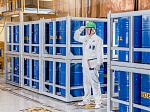03.11.2020
THE KOLSK NPP INFORMATION AND PUBLIC RELATIONS ADMINISTRATION
Industrial complex to deal with liquid radioactive waste at Kolsk NPP: Unique project to reduce man-made burden sustained by environmen
This opinion is shared by the participants of the discussion on preliminary assessment documents detailing environmental impact (AEI) of the complex that processes LRW with SRWM – solidified radioactive waste management at the Kolsk NPP, as well as materials of license justification (MLJ) for further use of this industrial object. The discussion took place at the town of Polyarnye Zory on November 2 and was held via means of remote communication.
156 and 130 people took part in the respective AEI and MLJ discussions, among them were members of the Public council on safe use of atomic energy at Murmansk region, representatives of public organizations, ecology experts, municipal leaders and local Council deputies. The public debates were broadcast via town cable television as well as to the fixed information screen at the central square of this town of nuclear professionals, and a questions session with the citizens was held via a dedicated hotline, among other means.
A draft version of SRWM was presented by the Director of Institute of industrial ecology issues in the North at Kola Science Center, Russian Academy of Sciences, Doctor of Technical Science Dmitry Makarov. The scientists have performed a whole set of field research, studied the state of land cover as well as the state of atmosphere and water ecosystem, and assessed the current radiological state of the Kolsky NPP region.
According to research data, shares of radionuclide emissions into the atmosphere at the NPP made up 1,61% of the total amount of permissible pollution as governed by the strict Russian health regulations. At the same time, the content of a cesium isotope in fish inhabiting nearby lakes is 22 times less the permissible limit, 267 less in lingonberry and 833 less in mushrooms.
“We shouldn’t expect any additional changes in quantitative or qualitative aspects of natural objects due to further utilization of PCLRW (processing complex for liquid radioactive waste) at the Kolsk NPP, whereas the environmental, organizational and technical measures realized at the NPP allow for a permissible stress on the environment and on public health,” Dmitry Makarov underlined.
First Deputy Chief Engineer at the Kolsk NPP Valery Kononov elaborated in his report on the specifics of the unique liquid radioactive waste processing technology that is used at the Kolsk NPP as well as the results of the PCLRW activity in the time period since 2006.
“Ion-selective purification technology allows to reduce the volume of storable radioactive waste (RAW) by more than 50 times. Trustworthy and secure work of the PCLRW allowed to reclassify more than 3 thousand tons of radioactive salts from radioactive waste to industrial waste in the last 14 years,” Valery Kononov explained.
The Ministry of Natural Resources in Russian Federation recognized the processing complex for LRW at the Kolsk NPP and the technology used therein as the best ecological project of the year.
The performance of the PCLRW at the Kolsk NPP exceeds the speed of liquid radioactive waste production, which leads to a constant reduction in volume of stored LRW. According to the public as well as experts, the Kolsk PCLRW should continue operating, because it truly contributes to reducing man-made stress on the environment.
Under current legislation, outcome documents of the public debate on preliminary AEI and MLJ materials concerning the use of the processing complex for LRW and SRWM at the.
Kolsk NPP will be included in the set of documents submitted to the State environmental assessment.


 career
career Innovations
Innovations Projects
Projects INTERNATIONAL BUSINESS
INTERNATIONAL BUSINESS